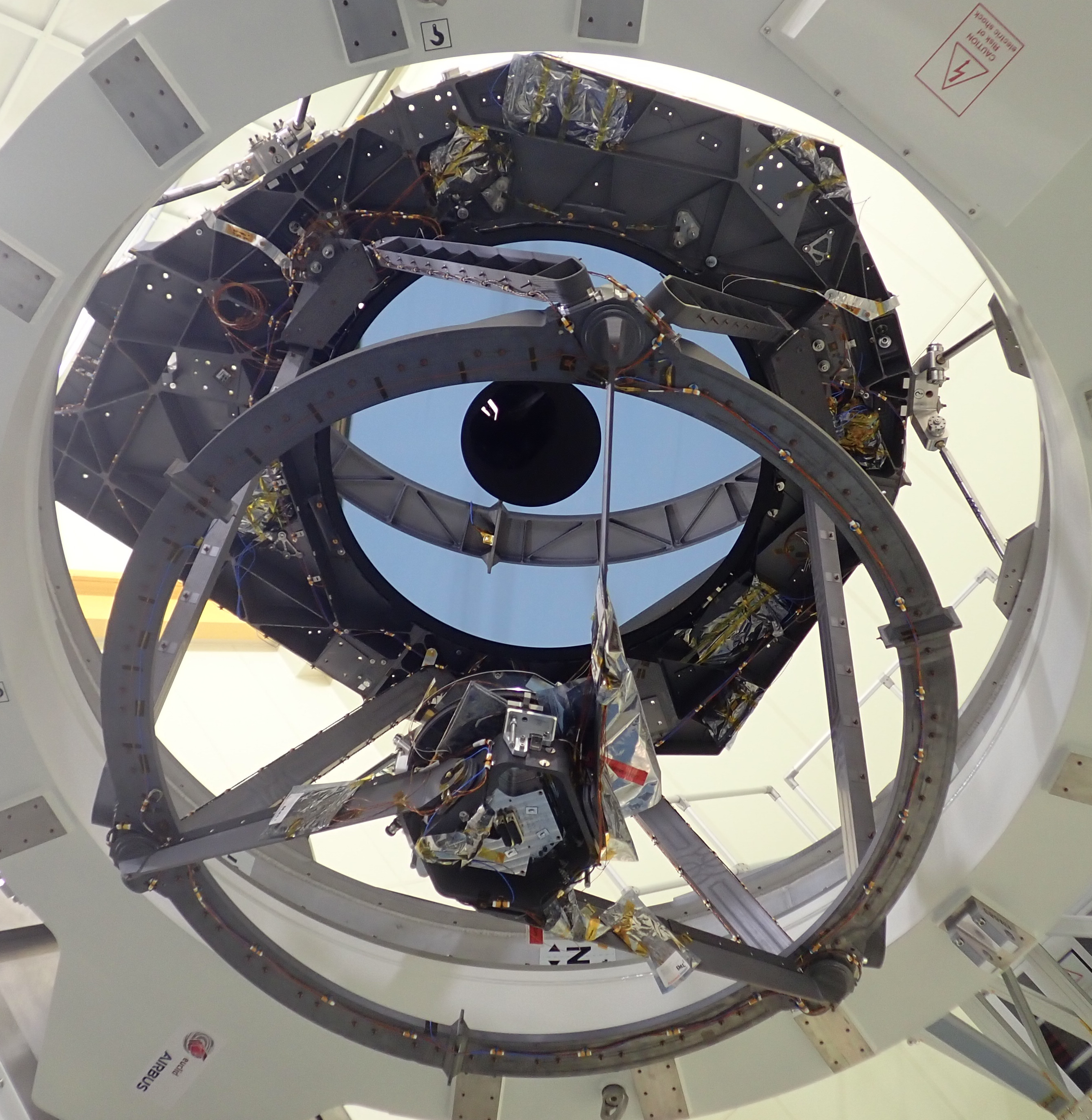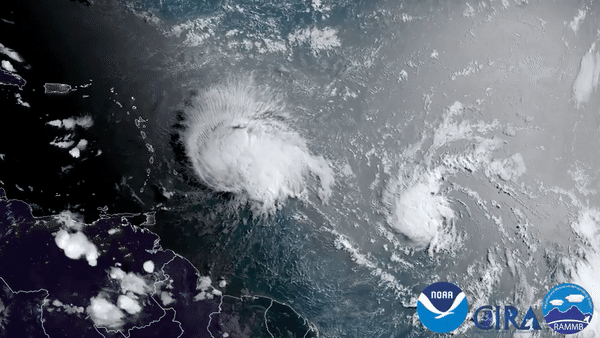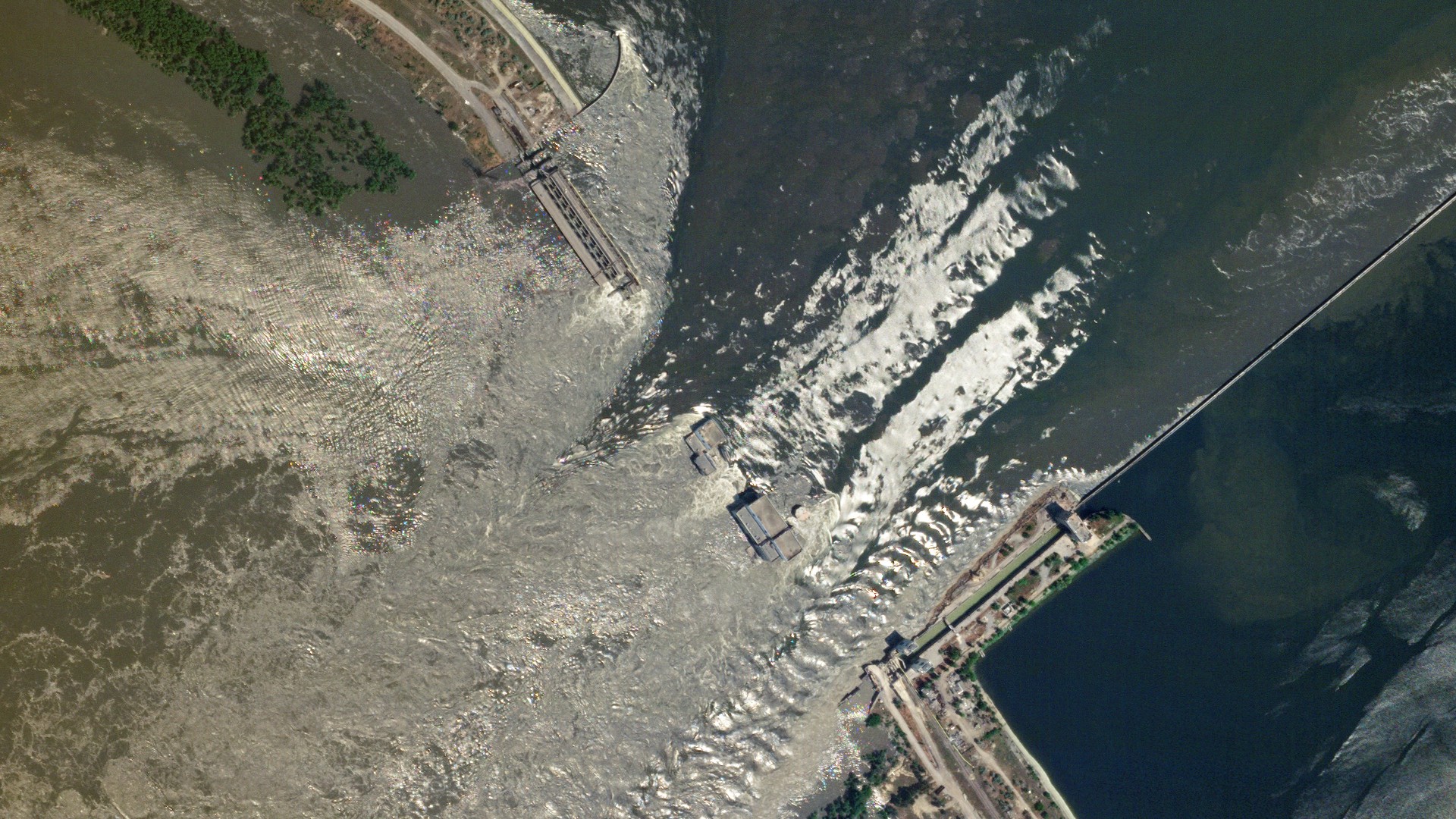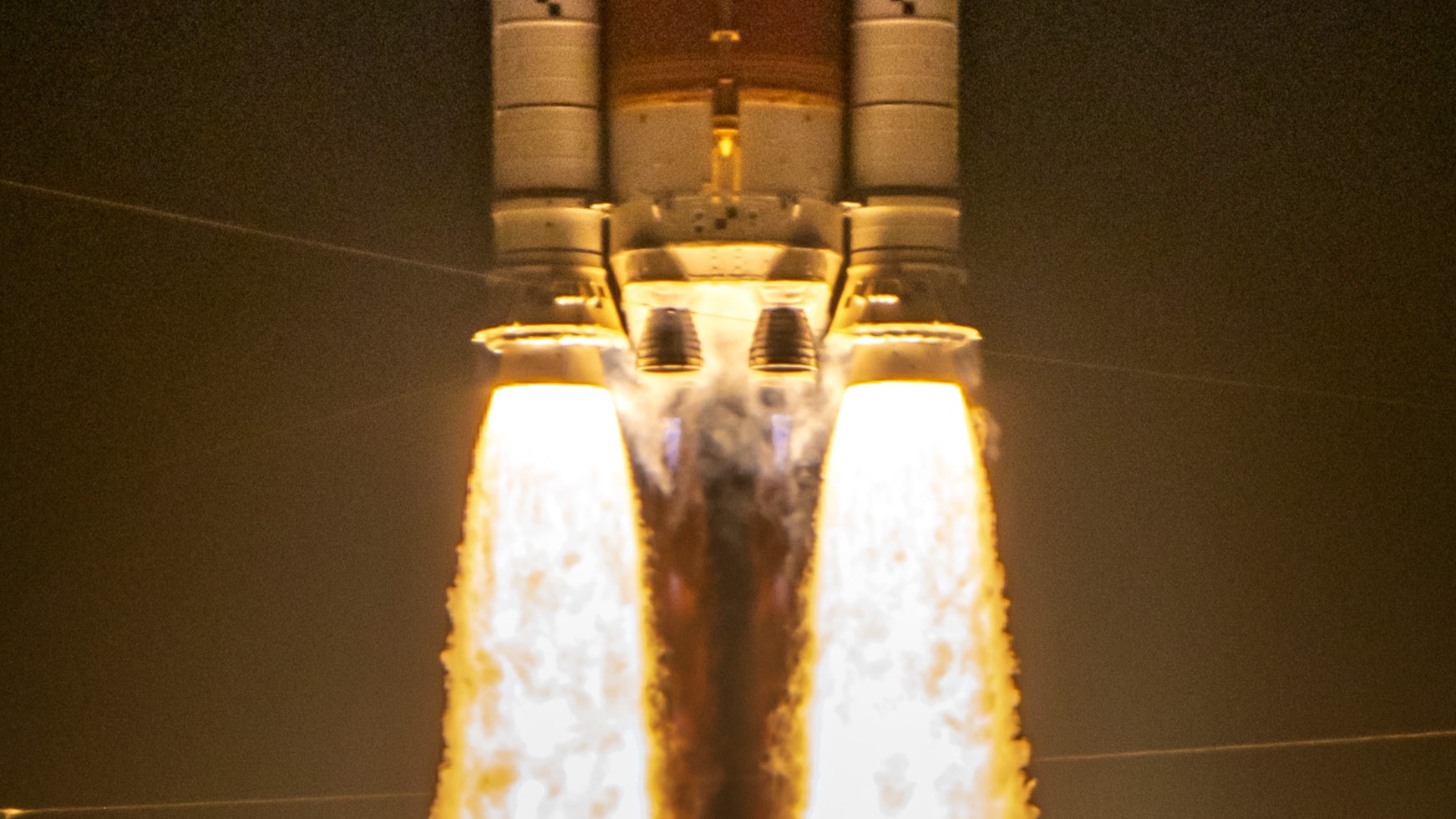June 2023
Stunning image reveals smoke from Canadian wildfires choking Afghanistan

Friday, June 30, 2023: Smoke from record-breaking wildfires in Canada has drifted across the Atlantic Ocean in the last week of June, reaching as far as Siberia and Afghanistan.
In this image taken by the Japanese weather satellite Himawari 9, a cloud of blue-tinged smoke hovers above a stretch of the Asian continent, covering an area of more than 380,000 square miles (1 million square kilometers.)
"[Smoke from Canadian fires] has traveled across the Atlantic and Europe and is now stretching from Afghanistan to Lake Baikal," Simon Proud, an Earth-observation scientist at the U.K. National Centre for Earth Observation, said in a Tweet, sharing the image. "That means the smoke covers an area of more than 1 million sq. km!"
Himawari 9 took the image from its perch in the geostationary orbit some 22,000 miles (36,000 km) above Earth. Proud processed the image and highlighted the wispy cloud with a red outline seen toward the edge of the globe just above the twilight zone.
The wildfires that have plagued Canada since May this year have produced an unprecedented amount of carbon emissions. The record-breaking blazes have erupted after an unusually dry spring amid a prolonged spell of hot weather in May. – Tereza Pultarova
Italian space tourists enjoy Virgin Galactic suborbital flight

Thursday, June 29, 2023: Italian space tourists Walter Villadei, Angelo Landolfi and Pantaleone Carlucci are posing with an Italian flag during a Virgin Galactic suborbital flight on Thursday, June 29.
The three men flew a set of experiments aboard the company's SpaceShipTwo spaceplane, which took them to the altitude of 55 miles (89 kilometers), just short of reaching the edge of space. During the flight, the passengers experienced about five minutes of weightlessness and enjoyed stunning views of our planet. The flight was Virgin Galactic's first commercial and second fully occupied ride to space. The company's owner Richard Branson was among the passengers on the first flight. – Tereza Pultarova
Get the Space.com Newsletter
Breaking space news, the latest updates on rocket launches, skywatching events and more!
Euclid's main mirror

Wednesday, June 28, 2023: This image of the main 1.2-meter main mirror of the dark energy-hunting telescope Euclid was taken during assembly and testing.
The telescope, built by the European Space Agency (ESA), will launch on Saturday, July 1, from Cape Canaveral in Florida. The spacecraft will join the James Webb Space Telescope in the Lagrange Point 2 some 900,000 million miles (1.5 million kilometers) from Earth and look for evidence of dark energy and dark matter by studying the distribution of galaxies in the distant universe.
Dark matter is the invisible material that makes up over 80% of all stuff that fills the universe that astronomers think must exist for the universe to make sense. Only when dark matter is taken into account do the gravitational forces observed in the universe stack up. Dark energy, on the other hand, is a similarly invisible force that seems to have something to do with the expansion of the universe. Euclid will take six years to answer the question whether these two mysterious forces actually exist. – Tereza Pultarova
Smoke from Canadian wildfires arrives in Europe

Monday, June 26, 2023: Smoke from wildfires in Canada has drifted across the Atlantic Ocean over the weekend and reached the coast of western Europe.
This image, taken by the European weather satellite Meteosat-10 on Sunday, June 25, shows a large plume of smoke spreading into the U.K. and Ireland and reaching Scandinavia.
Canada is experiencing one of its worst wildfire seasons following an extremely dry spring. According to Earth observation scientist Mark Parrington, of the European environment monitoring agency Copernicus, the fires are producing a record-breaking amount of carbon dioxide emissions. – Tereza Pultarova
Satellites observe futile race to rescue lost Titanic submarine crew

Friday, June 23, 2023: Earth-observation satellites of U.S. company Maxar Technologies photographed ships involved in the search for the lost Titan submarine which disappeared earlier this week during a descent to the wreck of the Titanic.
Multiple vessels were involved in the rescue operation which concluded on Thursday, June 22, after pieces of the missing submarine were found by an autonomous submersible near the Titanic wreckage. The nature of the discovered debris indicated that the Titan sub suffered a catastrophic implosion, which must have killed all passengers onboard in an instant. – Tereza Pultarova
Tropical depression Four follows tropical storm Bret across the Atlantic

Thursday, June 22, 2023: The 2023 Atlantic hurricane season is beginning to pick up momentum early as a new tropical depression forms in the trail of tropical storm Bret, which nearly became this year's first hurricane.
This video sequence was taken by the U.S. weather satellite GOES East from its perch in the geostationary ring, an orbit at the altitude of 22,000 miles (36,000 kilometers), where spacecraft appear suspended above a fixed spot on Earth.
The video shows Bret, which currently packs maximum sustained winds of 70 miles per hour (113 km/h), approaching islands in the eastern Caribbean Sea. Weather forecasters have issued warnings for residents in St. Lucia, Dominica and Martinique to prepare for strong winds and heavy rain later on Thursday (June 22).
Weather forecasters expect Bret to skirt Haiti and Cuba and begin to disintegrate above the Gulf of Mexico before reaching the strength of a hurricane. On Bret's heels follows tropical depression Four. The depression, which has formed in the early hours of Thursday, might strengthen later this week and become tropical storm Cindy, the third named tropical storm of the 2023 hurricane season.
The North Atlantic ocean is currently experiencing a spell of unusually high water temperatures, which might fuel further storm activity. The U.S. National Oceanic and Atmospheric Administration (NOAA) expects this year's hurricane season, which began on June 1, to be "near normal" with 12 to 17 named storms, five to nine hurricanes and one to four major hurricanes stronger than category 3. The first tropical storm of this season sprung up above the Atlantic Ocean already on June 3 but weakened within a few days. – Tereza Pultarova
Summer solstice from space

Wednesday, June 21, 2023: The Northern Hemisphere has woken up into the longest day of the year as our planet reached the moment of the summer solstice today, June 21, at 10:57 a.m. EDT (14:57 GMT).
This image shows our planet split by the terminator line that divides the dayside from the nightside of Earth, and was taken by the European weather forecasting satellite Meteosat-11 from its perch in the geostationary orbit, an orbit at the altitude of 22,200 miles (36,000 kilometers), where spacecraft appear suspended above a fixed spot on Earth's equator.
The changing length of the day and night on our planet is a result of Earth's tilt toward the plane in which it orbits the sun. As a result, the Southern and Northern Hemispheres receive varying amounts of sunlight each day of the year. The summer solstice marks the day when the Northern Hemisphere is the most tilted toward the sun, resulting in the longest day and warmest weather. From tomorrow on, days will begin to shorten in the north again, while the south will begin to move toward lighter and warmer days. – Tereza Pultarova
Return to Mercury

Friday, June 15, 2023: The European-Japanese BepiColombo probe took this image of its target planet Mercury as it approached it during a gravity-assist maneuver designed to reduce the spacecraft's speed.
The image was taken about seven hours before the closest approach on Monday (June 19) at a distance of about 75,000 miles (121,000 kilometers) from Mercury.
BepiColombo, which launched in 2018, is following a long and winding trajectory through the inner solar system designed to help the spacecraft shed kinetic energy with the help of planets Earth, Venus and Mercury. The probe, which currently orbits the sun, is constantly accelerated by the star's gravitational pull and needs to brake in order to slow down enough to be captured by the tiny Mercury in December 2028. The latest flyby, which took place on Monday (June 19) was already BepiColombo's third at Mercury. The probe previously performed one flyby of Earth and two of Venus. The spacecraft will revisit Mercury three more times before it will be finally able to enter its orbit. – Tereza Pultarova
The Extremely Large Telescope (ELT) is taking shape

Monday June 18, 2023: In Chile's Atacama desert, high in the mountains, the world's largest optical telescope is taking shape.
Construction of the Extremely Large Telescope (ELT) is going well as the steel frame of the telescope's dome is pierced together, bit by bit. When finished, the entire dome will weigh 6,100 tonnes and will house the primary mirror made up of almost 800 individual segments.
The ELT will be capable of collecting more light than all the existing 8- to 10-meter telescopes on the planet, combined. — Daisy Dobrijevic
Hubble inspects translucent galaxy for supernova remnants

Friday, June 16, 2023: The Hubble Space Telescope imaged a thin, hazy galaxy in search for remnants of a five-decade-old supernova.
The galaxy in question is called NGC 7292 and is located 44 million light-years away from Earth in the constellation Pegasus. In 1964, astronomers observed a giant star in that galaxy explode in a supernova and they hope Hubble will help them find traces of that explosion. Massive stars explode in supernovas when they run out of fuel in their cores. These explosions are so bright that they temporarily outshine entire galaxies. These explosions also have powerful effects on their neighborhoods, which astronomers want to study.
Even without a recent supernova, NGC 7292 is a curious object to observe. It has relatively few stars, which gives the galaxy its translucent look. Astronomers think the galaxy is held together mostly by the gravity of dark matter, the invisible stuff that according to theoretical models makes up 85% of all matter in the universe. – Tereza Pultarova
Europe hands over Orion service module for Artemis 2 mission

Thursday, June 15, 2023: The European Space Agency (ESA) officially handed over the service module for the Artemis 2 Orion spaceship, which will take humans to the moon next year, to NASA on Wednesday, June 15.
The Europe-built service module will propel Orion on its ground-breaking journey and provide water, air, electricity and temperature control to the four astronauts inside the capsule. The mission will last for about two weeks and will be the first in 50 years to take humans for a lunar roundtrip.
The European Service Module-2 will go through further tests before being mated to the Orion crew capsule later this year, ESA said in a statement. – Tereza Pultarova
Astronaut snaps a threatening cyclone approaching India

Wednesday, June 14, 2023: United Arab Emirates astronaut Sultan AlNeyadi took this photograph of cyclone Biparjoy swirling above the Indian Ocean earlier this week as the cyclone grew into the region's first major tropical storm of the season.
Classified as a very severe tropical cyclone, Biparjoy has forced thousands of people in India and Pakistan to leave their homes over the past few days. Packing maximum sustained winds of up to 90 miles per hour (145 kilometers per hour), Biparjoy is expected to make landfall on Thursday evening, according to weather forecasters.
AlNeyadi, who arrived at the International Space Station in March this year as part of the SpaceX Crew-6, posted the picture on his Twitter account on Wednesday, June 14. – Tereza Pultarova
The Great Lakes glint in moonlight in an eerie shot taken from the space station

Tuesday, June 13, 2023: This odd pattern of silverish blotches on a dark background is actually a nighttime image of the Great Lakes on the Canada–U.S. border.
The image, shared on Twitter by the Canadian Space Agency, was taken by astronauts aboard the International Space Station. Believe it or not, the strange spots are caused by moonlight reflecting off the lakes' surface, the space agency said in the tweet. – Tereza Pultarova
Hawaii's Kīlauea volcano continues to erupt

Monday, June 12, 2023: One of the world's most active volcanoes, Hawaii's Mount Kīlauea, continues to erupt as Earth-observing satellites fly overhead.
This image of the famous volcano on Hawaii's Big Island was taken by the European Earth-observing satellite Sentinel-2 on Sunday, June 11, and shared on Twitter by remote-sensing scientist Pierre Markuse who processed the data.
The eruption, while spectacular, currently poses no risk to inhabited areas as the boiling lava flows remain contained within a closed area of Hawaii Volcanoes National Park.
Kīlauea is the most active of Hawaii's five major volcanoes and one of the most active in the world. Its latest eruption began on June 7 after a quiet period of only three months. – Tereza Putarova
Hawaii's most active volcano wakes up

Friday, June 9, 2023: A satellite sees one of Hawaii's most active volcanoes wake up.
This image of the Kilauea volcano on Hawaii's Big Island was taken by a satellite operated by the U.S. Earth-observation company Maxar Technologies on Thursday, June 8, one day after the 4,100-foot-high (1,247 meters) volcano began spewing lava after a three-month hiatus.
The lava burst 200 feet high above the crater before spreading as glowing rivers of molten rock across the Hawai’i Volcanoes National Park. According to local authorities, inhabited areas are currently not at risk. – Tereza Pultarova
Satellite observes New York suffocate in Canadian wildfire smoke

Thursday, June 7, 2023: A thick blanket of smoke produced by wildfires in Canada hangs over New York and other major cities in the U.S. Northeast in this image captured by Europe's Sentinel 3 satellite.
The toxic smoke comes from dozens of wildfires that have been ablaze in Canadian provinces of Quebec and Nova Scotia since late May. The smoke spread hundreds of miles southward thanks to a low pressure system above the northwestern parts of the Atlantic Ocean that is funneling the orange-tinged cloud to the U.S.
According to CNN, the ash-filled haze had such an effect on air quality in New York that the city temporarily reached the rank of the world's worst air pollution hotspot on Tuesday, June 7. Under normal circumstances, New York sits comfortably outside the top 100, which is dominated by cities in India, Pakistan and China.
According to the Independent, the wildfire smoke may continue affecting air quality in the U.S. Northeast until the end of this week. – Tereza Pultarova
Satellite observes wildfire pollution spread across North America

Wednesday, June 7, 2023: The U.S. weather forecasting satellite GOES East observes how toxic air pollution from wildfires in Canada spreads southward to the U.S. Northeast.
High concentrations of harmful particles in the atmosphere have been reported from multiple regions in the north of the U.S. including New York City and Detroit with local authorities recommending sensitive people to limit their time outdoors.
The toxic air is wafting from Canada where powerful wildfires have been raging since last month. The record-breaking blazes erupted after an unusually hot month of May and an exceptionally dry spring. Air pollution from the wildfires has been detected as far south as South Carolina, according to NBC News. – Tereza Pultarova
Water escaping from destroyed dam in Ukraine seen from space

Tuesday, June 6, 2023: Satellite images by U.S. Earth observation company Planet reveal the extent of damage caused by an explosion to the Nova Kakhovka water dam in Ukraine that resulted in a catastrophic flooding in southeastern parts of the country.
The dam on Ukraine's largest river Dnipro partially collapsed after an explosion at about 3 a.m. on Tuesday, June 6. Some believe that Russia, which has been seen as losing its war to control Ukraine, is behind the explosion.
Since the explosion, water from the damaged reservoir has flooded the city of Nova Kakhovka and several municipalities in the region's largest city Kherson. The reservoir also provides drinking water to the Crimea peninsula, which is still controlled by Russia. – Tereza Pultarova
Smoke from Canadian wildfires spreading across the Great Lakes

Monday, June 5, 2023: Smoke from wildfires in Canadian provinces Ontario and Quebec can be seen spreading across the Great Lakes in this sequence captured by the U.S. weather satellite GOES-16.
The smoke can affect air quality on the U.S. side of the border especially in central and southwest Wisconsin and the greater Chicago area, according to the Cooperative Institute for Meteorological Satellite Studies at University of Wisconsin-Madison, which released the image sequence on Monday, June 5.
Devastating wildfires have broken out in several Canadian provinces last month after a spell of unexpectedly warm temperatures and an unusually dry spring. – Tereza Pultarova
Astronauts see Canada on fire from space

Friday, June 2, 2023: Astronauts aboard the International Space Station photographed a raging wildfire in the Canadian province of Nova Scotia that has nearly tripled in size in the past few days.
The fire that broke out near the town of Shelburne in late May has been described by local authorities as the worst ever to have hit Nova Scotia. On May 29, when this image was taken, the blaze was ravaging a forested area larger than 65 square miles (170 square kilometers) according to NASA.
Multiple fires broke out across Canada in late May amid a spell of unusually hot and dry weather which followed a spring of below average rainfall. Firefighters still struggle to contain the Shelburne fire, which has forced thousands of residents to leave their homes. – Tereza Pultarova
Artemis II Orion service module nearly assembled

Thursday, June 1, 2023: The service module that will power the Orion space capsule during the crewed Artemis 2 mission to the moon and back is nearly assembled.
The module, developed and built in Europe, has recently been moved to the Final Assembly and System Testing Cell at NASA's Kennedy Space Center in Florida where it will be integrated with the crew module, NASA said on Twitter. The completed space ship will then be handed over for fuelling. Artemis 2 follows the uncrewed Artemis 1 test mission that completed a successful lunar round trip in November and December 2022. Artemis 2 is expected to lift off at the earliest in November 2024. – Tereza Pultarova
Can't find the date you're looking for? It may have been a weekend or holiday, when we don't normally update our Image of the Day.
Click 'NEXT PAGE' below for July >
Check out our Image of the Day Archives for more awesome photos.
Image of the Day 2023 Archive

Image of the Day 2022 Archive

Image of the Day 2021 Archive

Image of the Day 2020 Archive

Image of the Day 2019 Archive

Join our Space Forums to keep talking space on the latest missions, night sky and more! And if you have a news tip, correction or comment, let us know at: community@space.com.

Space.com is the premier source of space exploration, innovation and astronomy news, chronicling (and celebrating) humanity's ongoing expansion across the final frontier. Originally founded in 1999, Space.com is, and always has been, the passion of writers and editors who are space fans and also trained journalists. Our current news team consists of Editor-in-Chief Tariq Malik; Editor Hanneke Weitering, Senior Space Writer Mike Wall; Senior Writer Meghan Bartels; Senior Writer Chelsea Gohd, Senior Writer Tereza Pultarova and Staff Writer Alexander Cox, focusing on e-commerce. Senior Producer Steve Spaleta oversees our space videos, with Diana Whitcroft as our Social Media Editor.
